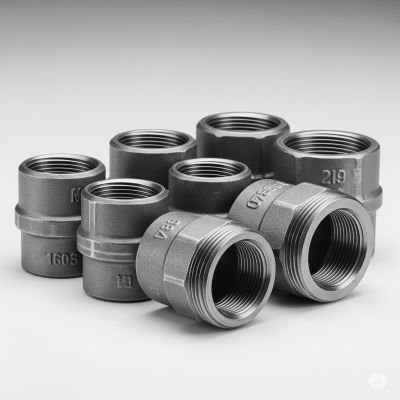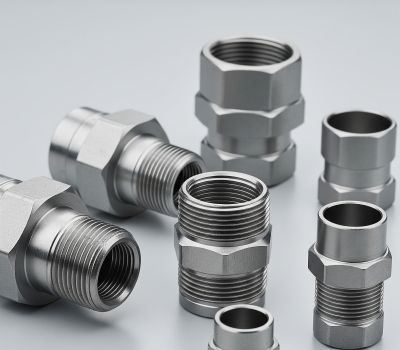When working with plumbing, mechanical systems, or DIY home projects, understanding different pipe threads is crucial. When the incorrect kind is used, it may result in annoying leaks, stripped fittings, or even system failure.
NPT, FIP, and MIP are some of the most prevalent thread types that you may come across. At first glance, they may appear similar. But knowing their differences is essential for safe and proper installation. This guide will break down each type and help you identify and use the right one every time.
What is NPT? (National Pipe Taper)
NPT stands for National Pipe Taper, a U.S. standard developed under ANSI/ASME B1.20.1. These threads are tapered, which means that as they go along, the diameter progressively gets smaller. This taper creates a mechanical seal as the male and female threads tighten together, especially when combined with sealants like Teflon tape or pipe dope.
NPT threads are the standard in U.S. plumbing, HVAC systems, compressed air, and hydraulics.
NPT vs NPS
-
NPT (National Pipe Taper): Threads taper to seal
-
NPS (National Pipe Straight): Threads are straight and require a gasket or O-ring to seal
NPT fittings are available in both male and female configurations.
What is FIP? (Female Iron Pipe)
FIP stands for Female Iron Pipe, which is simply the female-threaded version of an NPT fitting. It’s also known as NPT-F in some catalogs or specs.
FIP fittings have internal threads and are designed to accept male-threaded (MIP) parts. They’re common in applications like faucet and shower valves, couplings and unions, and tank inlets and outlets.
Despite the different name, FIP follows the same 60° tapered thread angle as NPT and creates a seal in the same way—with interference and thread sealant.
What is MIP? (Male Iron Pipe)
MIP, or Male Iron Pipe, is the external (male) counterpart to FIP. It’s also referred to as NPT-M in technical terms.
MIP fittings use a tapered design to create a seal after screwing into FIP fittings. You’ll commonly find MIP threads on water heater nipples, gas line connections, and plumbing supply lines.
Like FIP, MIP uses the NPT threading standard, so the names simply indicate thread gender, not a different standard.
Key Differences and Relationships
Here’s a side-by-side comparison of how NPT, FIP, and MIP relate:
|
Feature |
NPT |
FIP |
MIP |
|
Stands For |
National Pipe Taper |
Female Iron Pipe |
Male Iron Pipe |
|
Thread Type |
Standard (male or female) |
Female threads (internal) |
Male threads (external) |
|
Tapered? |
Yes |
Yes (NPT standard) |
Yes (NPT standard) |
|
Use Case |
Threading standard |
Receives male-thread fittings |
Screws into female fittings |
|
Common Confusion |
General label |
Mistaken as a separate type |
Mistaken as a separate type |
How to Identify Each Thread Type
Not sure what type you have? Use these methods:
Visual inspection:
➡️ MIP = external threads
➡️ FIP = internal threads
Look for markings: Parts often have labels like “FIP”, “MIP”, or “NPT” stamped or printed
Check for taper: Feel or measure for narrowing thread diameter
Use tools: A thread pitch gauge and calipers can confirm pitch and diameter
Practical Applications and Tips
Here are some real-world insights for using these thread types:
➡️ MIP to FIP is the most common connection (e.g., water heaters, toilets, valves)
➡️ Use Teflon tape or pipe dope on NPT connections unless the fitting has a built-in seal
➡️ Avoid overtightening—it can lead to cracked fittings or stripped threads
Always verify thread standards, especially when dealing with international fittings that may be BSP or metric
Still unsure? Take your fitting to a hardware store to match it in person.
FAQs
Is FIP the same as NPT?
Not exactly. FIP uses NPT thread standards, but it refers specifically to female-threaded fittings.
Can MIP and NPT connect?
Yes. MIP is just the male version of NPT. It threads directly into FIP fittings.
Do I need sealant on MIP or FIP threads?
Yes—unless the part includes a built-in O-ring or compression seal, always use Teflon tape or pipe thread compound.
Is NPT universal worldwide?
No. Other countries often use BSP (British Standard Pipe) or metric threads, which are not compatible with NPT.
Conclusion
To recap:
1. NPT is the U.S. standard for tapered threads
2. FIP is the female-threaded version of NPT
3. MIP is the male-threaded version of NPT
Knowing these differences helps you avoid cross-threading, leaks, and costly mistakes. Whether you’re replacing a shower valve or setting up a gas line, make sure you’re matching the right thread type for your system.
When in doubt, bring your fitting to a hardware store or use a thread ID gauge.
Post time: May-23-2025




